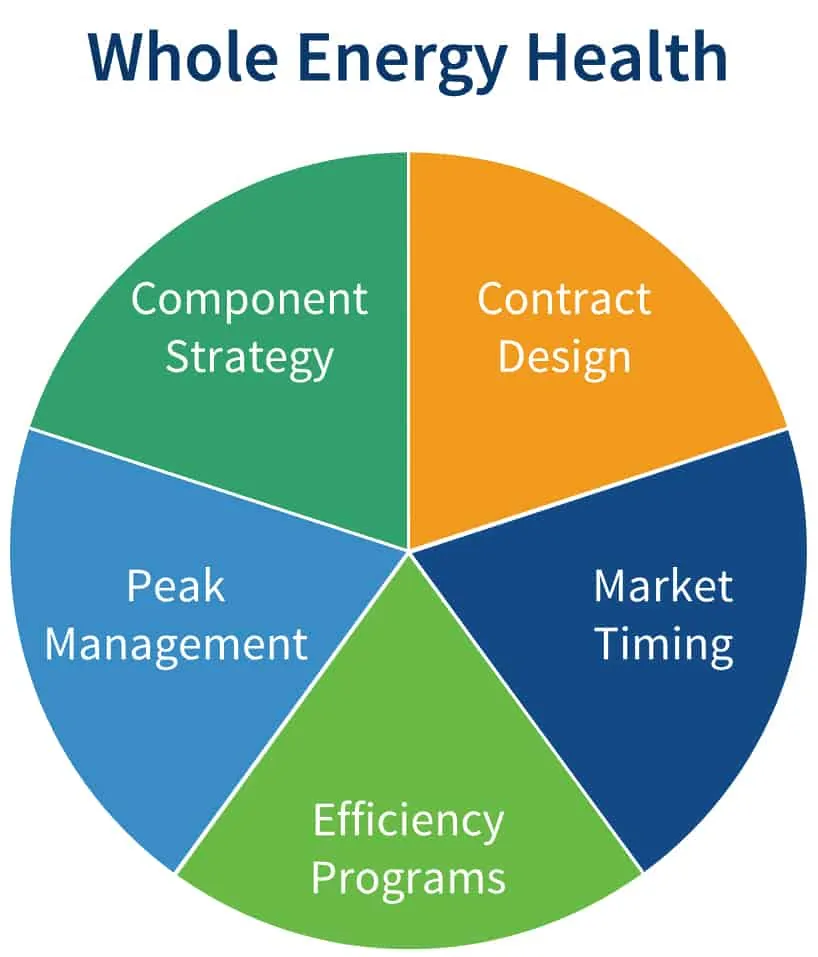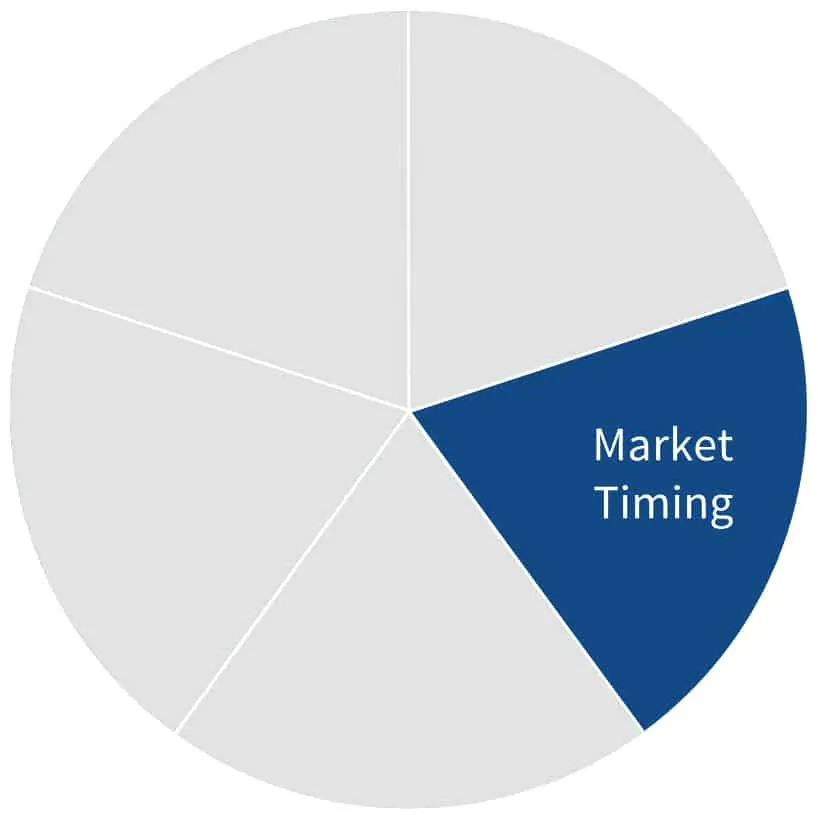Best Practice Energy was founded with one goal: Help businesses purchase their electricity and natural gas in innovative ways that help them avoid significant costs.
This goal has been the heartbeat of our company for the last ten years and has led to the development of a new, managed approach to purchasing energy that we call Whole Energy Health. At its core, Whole Energy Health is designed to elevate the value of our clients’ electricity and natural gas contracts by using tailored strategies to attack each component of their energy price.
We often help clients design and implement their future contracts using this turnkey solution. But what happens when a potential client is already in another contract when we first talk to them? We can always help them achieve cost avoidance on their future bills, but can we still help them achieve it with their current ones?
Read on to find out!
Persistence is Key
In 2017, chance brought us face-to-face with the facilities manager at a textile manufacturing plant.
After a quick conversation about their current energy purchasing situation, we learned that their broker had not used any strategy when building their contract and just put them in an all-in fixed price. When it came time to look at the budget, they told us upper management was not happy at all with how much they were paying for electricity and natural gas.
After looking at their deal, our CEO and President Bryan Yagoobian identified a multitude of weak spots in their current electricity contract. Bryan explained to the facilities manager that we could help them restructure this contract to put them on a path towards cost avoidance if they just made us their broker of record.
Like we do for all our potential clients, Bryan offered him a free consultation to show him what a tailored strategy could accomplish.
While he did like the proposal, the facilities manager wasn’t ready to make any move citing that their contract wasn’t up for another two years. They opted to speak to us once they were ready to start their new contract.
Knowing that we could easily get them into a much better contract that they would see results from almost immediately, Bryan wouldn’t take ‘no’ for an answer.
He put them on a market watch and contacted them daily to show the prices they were missing out on capturing with the way their current contract was set up.
After multiple conversations, the facilities manager saw the value of what Bryan was proposing. He finally broke down and accepted our offer of a free consultation to see what we could actually do for them.
Anyone can get you a price; it’s about how you get that price and what you do with it. It’s all about the strategy.
Bryan Yagoobian, Best Practice Energy President & CEO
Once we got the confirmation, the entire Best Practice Energy team got to work.
Optimizing a Deal
Our first step was to audit their existing contract as well as all their load history.
After a first pass at everything, it was obvious that their broker was not doing anything to optimize the value of their contract:
- Their purchasing strategy was very transactional in nature and was not tailored to their needs or budget.
- The former broker captured the electricity price that was available when the client’s contract began and fixed that in for the rest of its length without any strategy.
- The client had the type of operations that allowed for peak management, but they were not passing their capacity costs through so they did not have any curtailment strategy to speak of.
In short, their current contract was using an outdated strategy to purchase energy that resulted in a lot of unneeded costs.
Most surprising of all, the contract the broker had them sign included no protective terms and conditions, a very high margin, and no price spiking protection.
Bryan then presented our plan to restructure and optimize their contract. He told the facilities manager that even though there were multiple years left on their deal, there was a lot of missed opportunity to capture cost avoidance over the next couple of months.
Without much hesitation, the manufacturer decided to make us their broker of record. Once the paperwork was all set, we began implementing our managed, turnkey solution, Whole Energy Health.
Designing a Strategy for Each Component
The first step was to look at all of the components of their electricity supply price and develop a strategy for each.
In doing this, we identified opportunities to manage down the client’s energy commodity costs as well as their capacity costs. This helped dictate and form a tailored strategy for their new contract.
Contract Design: A New, Tailored Purchasing Strategy
Next, we performed a deeper audit of all of their energy contract, usage, and bill history. This helped us construct a path towards cost avoidance by attacking many past missteps from their previous deals.
When designing a contract for clients, one thing that always needs to be discussed is their risk tolerance. This is because we develop a cost avoidance strategy around the amount of market risk they can handle.
With this client, we determined that a seasonality approach to their new purchasing strategy would be best.
We put them on a common purchasing strategy we use for many of our New England clients that is aptly named, The New Englander. This hedging strategy allows clients to fix/hedge a portion of their price in the winter & summer and then index their price in the spring and autumn months.
By doing this, the client was not forced to pay a premium for a guaranteed, fixed price.
This purchasing strategy attacked the ‘energy’ portion of their bill, the actual electricity commodity. Next, we looked at how we could attack the capacity portion of their price.
After looking at their operations, we confirmed our initial assessment that they had the ability to curtail their operations during peak events to manage their capacity costs down. When they agreed, we passed their capacity costs through on their contract to allow them to curtail.
We took this new contract and posed it to multiple suppliers through our proprietary bidding platform. Once we found the right tier 1 supplier and price for them, we began implementing the strategies.
Timing the Market
As soon as the new contract began, we immediately put them on a market watch. Here, we identified peaks and valleys as well as trends to pinpoint the best times to purchase pieces of the energy price component.
Because they were using a variation of The New Englander purchasing strategy, the first step was to look at the winter & summer months and find some prices to hedge portions of their contract for those months. We didn’t have to worry about the spring & fall months because, by the terms of The New Englander plan, those prices were indexed.
Now, forecast can dramatically impact a price so we heavily weight this when watching for prices. Looking at Rhode Island’s winter forecast that year, however, we did not see anything that supported price increases. We found a good price and laid out our recommendations to the client. They opted to hedge 40% of their contract that winter and leave the rest open to purchase.
During this time, we were also working on their next contract that didn’t start for another two years. Since prices that are further out are significantly less volatile, we started hedging portions of this next contract when we saw prime opportunities.
Managing Capacity Costs with Peak Management
The idea behind Whole Energy Health is to attack each portion of a price and find ways to avoid costs with each.
After we felt comfortable with the strategy we had in place for the commodity piece, we began working on the capacity portion of their bill. This was something we identified during the contract design process as a potential area they could avoid costs in.
Because we made this determination early on, we made sure to include that they would be passing their capacity costs through from the previous year in their contract to enable them to curtail their load.
To start them off on capacity management, we sent our Peak Notification Service to the client to discuss a plan. After doing a deep dive into their operations, our Service helped them design a curtailment strategy in which they would shift some of their manufacturing to later in the day when we forecasted and notified them of an incoming peak event.
Months later when the peak event came, they implemented their curtailment strategy and ended up reducing their capacity tag by 600 kW, which resulted in roughly $50,000 saved on their capacity costs the following year!
Epilogue – Working in Synergy
All-in-all, the restructuring of the manufacturer’s deal using Whole Energy Health led to a total of $450k saved over the course of the entire 4-year contract!
While our rebuilding of the contract architecture accounted for about $200k of these savings, the client’s successful implementation of a curtailment strategy achieved $250k in cost avoidance! This is why businesses that work with energy consultants often see greater results: Maximum energy cost avoidance is the result of a harmonious partnership between the client and energy consultant.
After seeing the results of Whole Energy Health on their budget, upper management was understandably enamored. The facilities manager helped them come to the realization that, on top of the lower price they received, they also got a sophisticated strategy that would drive future costs down too! Needless to say, they were very excited to get to work on their next contract with us.
So, what’s the point of this story?
That’s part of it, but there is more!
That’s another huge part of it, but there is still more!
Another really important aspect of intelligently purchasing and managing energy, but the main point is broader than that!
We won’t make you guess anymore so here it is: Just because you’re in a current deal with another energy broker does not mean that you can’t restructure it!
We constantly get into conversations with businesses who love what we’re offering, but come back with something along the lines of, “That sounds great and all, but I’m still in a contract with another broker. Let’s talk when our contract is almost done.”
This is an antiquated and outdated approach to purchasing energy! Just because you’re already in a contract does not mean you can’t restructure it with another consultant. It also doesn’t mean you can’t start hedging pieces of a future contract years before it starts! This is the modern, sophisticated way of purchasing energy that can lead to thousands saved in cost avoidance.
Had this client just listened to their incumbent broker, they would’ve continuously signed a fixed price contract and never would’ve discovered the amount of costs they could’ve easily avoided with a tailored strategy!
So, contact us today, even if you’re still in a contract with a broker, supplier, or utility, and we will show you what you’re missing out on with a free electricity and natural gas consultation!










